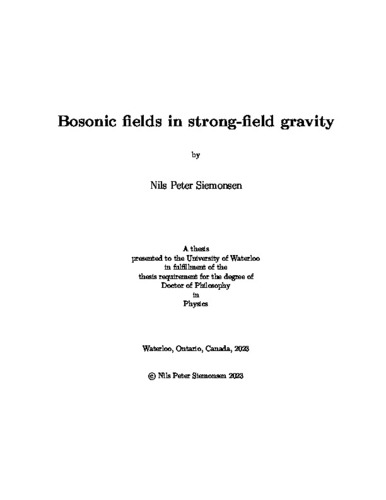| dc.description.abstract | In this thesis, we investigate bosonic fields in the strong-field and highly dynamical regime of general relativity focusing specifically on the black hole superradiance process of scalar and vector fields, as well as on the nonlinear dynamics of isolated and binary scalar boson stars. In the first part of this thesis, we lay the foundation to use boson stars as a particularly simple model to explore the dynamical behavior of inspiraling and merging ultra compact and black hole mimicking objects. To that end, we construct self-consistent initial data describing isolated and binary star configurations and subsequently utilizing numerical evolutions of the full Einstein-Klein-Gordon system of equations to explore this dynamical behavior. We investigate the linear stability properties of families of rotating stars in scalar theories with various types of self-interactions. Using numerical evolutions, we find that a linear instability present in rotating boson star solutions within linear scalar theories is quenched by nonlinear scalar interactions in a subset of stars. Furthermore, utilizing the conformal thin-sandwich formalism, we numerically construct generic binary
boson star initial data satisfying the constraints of the Einstein equations. We adapt existing and introduce new methods, to initial data quality, as well as reduce residual orbital eccentricity. With these methods, we were able to generate self-consistent inspiral-merger-ringdown gravitational waveforms of eccentricity-reduced binary boson stars, for the first time. Lastly, scalar self-interactions may delay the merger time of identical inspiraling binary star configurations, or drive the system to an entirely different end state. In particular, we show explicitly that rotating boson stars can form during the merger of two non-spinning stars. In the second part of this thesis, we focus on how well-motivated ultralight scalar and vector bosons, extending the Standard Model of particle physics, can be probed through the observable signatures of the black hole superradiance process. Energy and angular momentum are extracted from a black hole via this mechanism, are deposited
in an oscillating bosonic cloud, and finally dissipated through gravitational wave emission from the system. Here, we introduce the gravitational waveform model, SuperRad, modeling the cloud’s oscillation frequency, growth and decay timescales, as well as the amplitude and phase evolution of the emitted gravitational radiation, for both scalar and vector boson clouds. This model combines state of the art analytical results with numerical computations to provide the most accurate predictions across the relevant parameter space. Moreover, we investigate the impact of a non-vanishing kinetic mixing between an ultralight vector boson forming a superradiant cloud and the Standard Model photon. Such mixing robustly results in the formation of a highly turbulent pair plasma within the bosonic cloud. We characterize the associated electromagnetic signatures and devise strategies to observe such signatures through multi-messenger observation campaigns. | en |

